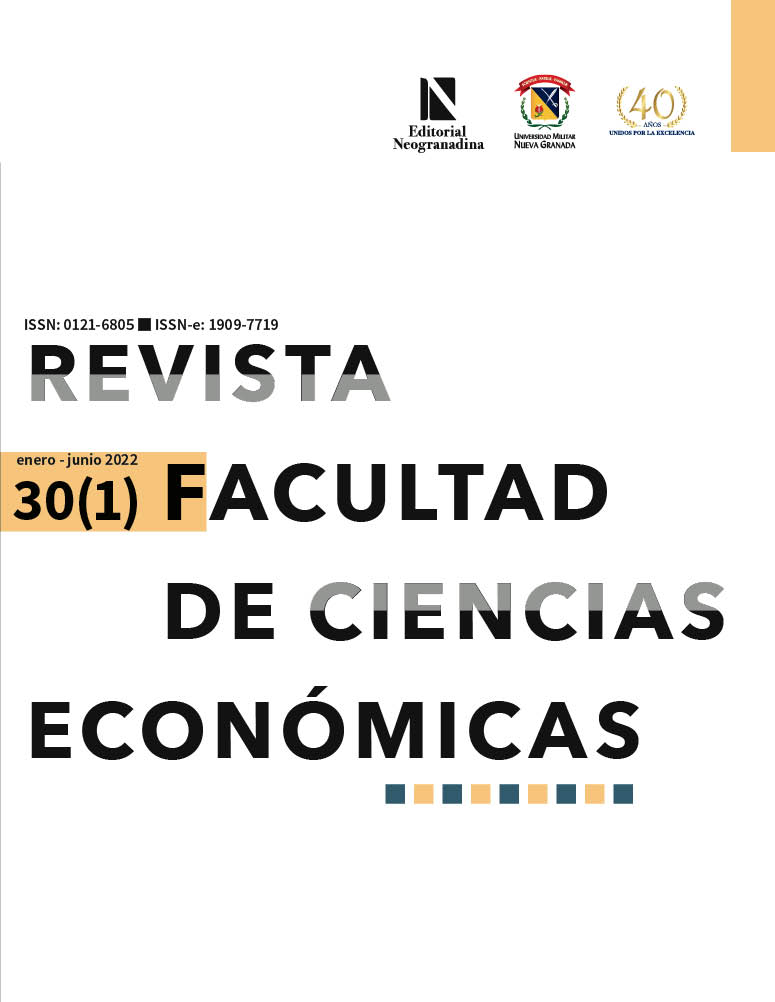Informal Economy and Income Distribution in Ecuador During the COVID-19 Pandemic
Abstract
This paper seeks to analyze the evolution of labor informality in Ecuador during the coronavirus. The analysis uses microdata from household surveys for 2019 and 2020 to contrast the evolution of informality rate and income. A wage decomposition model is used to estimate the variation in income between the two periods. The results show an annual drop of 11 % in the informal population working a year ago; however, the informality rate rose by 2 %. This behavior is contextualized by a 20 % decrease in the hours worked per week and a 29 % in hourly labor income.
Downloads
References
Acevedo, I., Castellani, F., Lotti, G., & Székely, M. (2021). Informalidad en los tiempos del COVID-19 en América Latina: implicaciones y opciones de amortiguamiento. Documento de trabajo del BID No IDB-WP-01232. DOI: https://doi.org/10.18235/0003220
Albornoz, V., Ricaurte, M., & Oleas, S. (2011). La informalidad en el Ecuador 2000-2009. In Temas de economía y política (volume 19). CORDES. https://www.losexplicadores.com/vicente/articulos/19_Informalidad.pdf
Allen, J., Nataraj, S., & Schipper, T. C. (2018). Strict duality and overlapping productivity distributions between formal and informal firms. Journal of Development Economics, 135, 534-554. DOI: https://doi.org/10.1016/j.jdeveco.2018.08.011
Amin, M., Ohnsorge, F., & Okou, C. I. F. (2019). Casting a Shadow: Productivity of Formal Firms and Informality. World Bank Policy Research Working Paper, (8945). DOI: https://doi.org/10.1596/1813-9450-8945
Arango, L. E., & Hamann, F. (Eds.). (2013). El mercado de trabajo en Colombia: hechos, tendencias e instituciones. Banco de la República.
Arango, L. E., & Posada, C. E. (2001). El desempleo en Colombia. Borradores de Economía, 176, 1984-2005. https://www.banrep.gov.co/docum/ftp/borra265pdf.pdf
Blinder, A. S. (1973). Wage discrimination: reduced form and structural estimates. Journal of Human Resources, 436-455. DOI: https://doi.org/10.2307/144855
Botello, H. (2014). Determinantes del ciclo de crédito en los municipios cafeteros de Ecuador. Revista Sinapsis, 6(1), 124-131.
Coase, R. H. (1960). The problem of social cost. In Classic papers in natural resource economics (pp. 87-137). Palgrave Macmillan. DOI: https://doi.org/10.1057/9780230523210_6
Coibion, O., Gorodnichenko, Y., & Weber, M. (2020). Labor markets during the COVID-19 crisis: A preliminary view (No. w27017). National Bureau of economic research. DOI: https://doi.org/10.3386/w27017
Coombs, C. (2020). Will COVID-19 be the tipping point for the intelligent automation of work? A review of the debate and implications for research. International journal of information management, 55, 102182. DOI: https://doi.org/10.1016/j.ijinfomgt.2020.102182
Daymont, T. N., & Andrisani, P. J. (1984). Job preferences, college major, and the gender gap in earnings. Journal of Human Resources, 19(3), 408-428. DOI: https://doi.org/10.2307/145880
Doeringer, P., & Piore, M. J. (1971). Internal labor markets and manpower adjustment. DC Heath and Company.
ECLAC (2020). Balance Preliminar de las Economías de América Latina y el Caribe 2020.
Gamero, J., & Pérez, J. (2020). Perú: Impacto de la COVID-19 en el empleo y los ingresos laborales. OIT.
García, J. I. U., Quevedo, C. H. O., & Cruz, G. A. G. (2008). Informalidad y subempleo en Ecuador: dos caras de la misma moneda. Cuadernos de Administración, 21(37).
García, L. F., & Cruz, M. (2017). Desempleo en América Latina: ¿flexibilidad laboral o acumulación de capital? Problemas del desarrollo, 48(189), 33-56. DOI: https://doi.org/10.22201/iiec.20078951e.2017.189.57821
Goraus, K., & Tyrowicz, J. (2014). Gender wage gap in Poland-can it be explained by differences in observable characteristics. Ekonomia, 36(1), 125-148.
Hamann-Salcedo, F. A., Mejía, L. F., & Hamann, F. (2012). Formalizando la informalidad empresarial en Ecuador. Capítulo 10. (pp. 399-427). DOI: https://doi.org/10.32468/be.676
Harris, J. R., & Todaro, M. P. (1970). Migration, unemployment and development: a two-sector analysis. The American economic review, 60(1), 126-142.
Hart, K. (1970). Small Scale Entrepreneurs in Ghana and Development Planning. The Journal of Development Studies, VI, 61-89.
Heckman, J. J. (1979). Sample selection bias as a specification error. Econometrica: Journal of the econometric society, 47(1), 153-161. DOI: https://doi.org/10.2307/1912352
Heras, R. L. (2020). Impacto del COVID-19 en el mercado de trabajo: un análisis de los colectivos vulnerables. Documentos de Trabajo (IAES, Instituto Universitario de Análisis Económico y Social), (2), 1-29.
Hsiang, S., Allen, D., Annan-Phan, S., Bell, K., Bolliger, I., Chong, T., ... & Lau, P. (2020). The effect of large-scale anti-contagion policies on the COVID-19 pandemic. Nature, 584, 262-267. DOI: https://doi.org/10.1038/s41586-020-2404-8
ILO. (2020). Updated estimates and analysis. ILO Monitor: COVID-19 and the World of Work.
Kelmanson, M. B., Kirabaeva, K., Medina, L., Mircheva, M., & Weiss, J. (2019). Explaining the shadow economy in Europe: size, causes and policy options. International Monetary Fund. DOI: https://doi.org/10.2139/ssrn.3523151
Lemieux, T., Milligan, K., Schirle, T., & Skuterud, M. (2020). Initial impacts of the COVID-19 pandemic on the Canadian labour market. Canadian Public Policy, 46(S1), S55-S65. DOI:https://doi.org/10.3138/cpp.2020-049
Lewis, A. (1954). Economic development with unlimited supplies of labour. Manchester School of Economic and Social Studies, 22, 139-191. DOI: https://doi.org/10.1111/j.1467-9957.1954.tb00021.x
Maurizio, R., & Vázquez, G. (2015). Desigualdad e informalidad en América Latina: el caso del Ecuador. Desigualdad e informalidad: un análisis de cinco experiencias latinoamericanas. CEPAL. DOI: https://doi.org/10.18356/a265b870-es
Mejía, D., & Posada, C. E. (2007). Informalidad: teoría e implicaciones de política. Borradores de Economía, 455. DOI: https://doi.org/10.32468/be.455
Mondragón Vélez, C., Peña, X., & Wills, D. (2012). Rigideces laborales y salarios en los sectores formal e informal en Ecuador. Capítulo 15. In El mercado de trabajo en Colombia: hechos, tendencias e instituciones (pp. 631-671).
Oaxaca, R. (1973). Male-female wage differentials in urban labor markets. International economic review, 14(3), 693-709. DOI: https://doi.org/10.2307/2525981
Ocampo, T. L. G., & Sabogal, Y. T. C. (2018). Tributación y pobreza en Ecuador: un análisis desde la evolución del impuesto de renta y el índice de pobreza monetaria. Revista Activos, 16(30),79-98. DOI: https://doi.org/10.15332/25005278.5061
Ortiz, C. H., Uribe, J. I., & García, G. A. (2007). Informalidad y subempleo: un modelo probit bivariado aplicado al Valle del Cauca. Revista Sociedad y economía, (13), 104-131. DOI: https://doi.org/10.1016/S0123-5923(07)70001-3
Perry, G. E. (2008). Informalidad: escape y exclusión. Banco Mundial con Mayol Ediciones.
Rodríguez, M., & James, J. (2017). La informalidad laboral colombiana en los últimos años: análisis y perspectivas de política pública. Revista de Métodos Cuantitativos para la Economía y la Empresa, 24, 89-128.
Rodríguez-Soto, J. R., & Dussán-Pulecio, C. (2018). La informalidad empresarial, evolución literaria que denota un fenómeno complejo. Polo del Conocimiento, 3(8), 561-578. DOI: https://doi.org/10.23857/pc.v3i8.655
Ruesga, M., Pérez, l., & Delgado, J. (2020). Sector informal en Ecuador: Perspectiva desde el escenario econométrico. Revista Espacios, 41(14).
Sandoval, G. (2014). La informalidad laboral: causas generales. Equidad y desarrollo, 1(22), 9-45. DOI: https://doi.org/10.19052/ed.3247
Taubman, P. & Wachter, M. (1986). Segmented Labor Markets. In Handbook of Labor Economics (volume II). Elsevier Science Publishers. DOI: https://doi.org/10.1016/S1573-4463(86)02011-4
Tokman, V. E. (1987). El sector informal: quince años después. El trimestre económico, 54(215(3)), 513-536.
Uribe, J. I. (2006). Informalidad laboral en Colombia, 1988-2000: Evolución, teorías y modelos. Universidad del Valle. DOI: https://doi.org/10.2307/j.ctv14jx8hf
World Bank (2012). Ecuador: las caras de la informalidad.
World Bank (2020). The Economy in the Time of COVID-19. https://openknowledge.worldbank.org/bitstream/handle/10986/33555/9781464815706.pdf?sequence=10&isAllowed=y
Copyright (c) 2022 Revista Facultad de Ciencias Económicas

This work is licensed under a Creative Commons Attribution-NonCommercial-NoDerivatives 4.0 International License.












